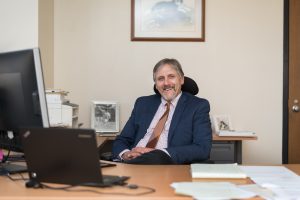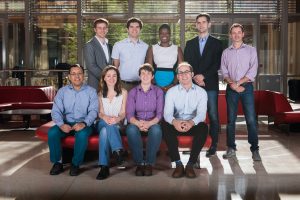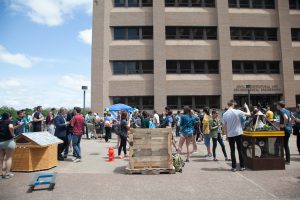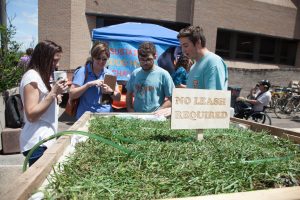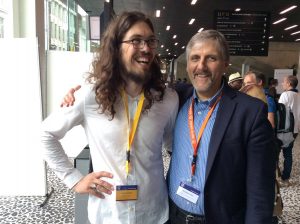In the aftermath of Hurricane Harvey there is a lot of talk about water, and rightfully so. Overwhelming amounts of contaminated water are an immediate concern. Some have lost their lives in it. Some have been infected by it. Over 100,000 homes have been flooded by it. Many of these will not be recoverable. We have watched Houston and surrounding areas of Southeast Texas drown before our very eyes. But the water will subside. Families will return to their homes. Children will return to their schools. Many will return to their workplaces. The buildings that they return to will be remediated and renovated to various degrees and by various means. But as life gets back to “normal”, those in the affected areas will have prolonged exposure to a wide range of air pollutants in their homes, schools, workplaces, and in other buildings which they frequent.
An immediate concern is the use of portable gasoline generators that some might choose to use indoors if they do not have power. After most natural disasters there are deaths caused by carbon monoxide poisoning stemming from generator exhaust. Death comes quickly and can kill an entire family before anyone detects what is happening. DO NOT USE PORTABLE GENERATORS INDOORS!
The media and most of the public will focus on mold in homes and schools. Mold is an important concern, as are other biological agents ranging from harmful bacteria and amoeba that can deposit and thrive on and in wet building materials. Many will hire companies to clean their homes by removing water-damaged and mold and bacteria-infested gypsum board, insulation, carpet, and furniture, scrubbing studs in walls with chlorine solution, and using fans, heaters, and dehumidifiers to remove moisture. Others will not have the economic benefit of hiring professionals, and will do the best they can by themselves or with the help of friends. In this case there is high potential for exposure to harmful chemical and biological agents if proper precautions are not taken.
The remediation of water-damaged buildings across Southeast Texas will cost home and other building owners many billions of dollars, feeding a cottage industry that is not constrained by many regulations. Biological remediation of buildings is not a well-established science and is often empirical, at best. The efficacy of such remediation will vary from building to building and by companies and individuals contracted to do the work. It is prudent to become educated on clean-up after floods and mold in homes, schools and other buildings. The U.S. Environmental Protection Agency has a lot of very good and practical information on their website related to these topics, including answers to frequently asked questions. The link to flood cleanup information is here:
https://www.epa.gov/indoor-air-quality-iaq/flood-cleanup-protect-indoor-air-quality
I encourage anyone who is dealing with flooded homes or schools to review this site. There is also a page dedicated specifically to information on mold cleanup after floods:
https://www.epa.gov/mold/mold-cleanup-after-floods
Harmful biological agents often deposit in cracks and crevices and are difficult to find and remove in these spaces. Because of this, treatment of whole buildings or building zones by injection of decontamination agents such as chlorine dioxide or vaporized hydrogen peroxide in air is sometimes used, allowing the possibility of reaching biological agents in hard-to-reach places. A similar technique is used to remove lingering odors by injecting ozone into buildings. My team at the University of Texas at Austin has done significant research on the chemistry of building decontamination and deodorizing agents. Ozone, for example, leads to the formation of reaction products (new chemicals) through its chemical reactions with materials in buildings. These reaction products can be irritating or worse, and some can persist in buildings for days to months. My team also has evidence that, depending on the mode of generation and conditions of application, treatment of buildings with chlorine dioxide can lead to reaction products. Some of these are similar to reaction products generated by ozone. Proper re-entry planning of buildings following any remediation effort is important. Waiting at least several days or longer after remediation is smart.
Importantly, NEVER be present when a home is being treated with a whole-home decontamination agent. This might sound obvious, but in times of crises people sometimes do not think straight. For example, several years ago I was involved with a case where a home was treated with ozone for odor decontamination. The family was not told to leave the house DURING ozone usage and became very ill. My forensic analysis suggested that the family was exposed to ozone levels that approached those immediately dangerous to life and health. The ozone also adversely affected rubber gaskets and other seals in the home, cracking them beyond further use, and also effectively destroyed several works of art. It left the home filled with lingering reaction products that were noticeable by smell months after the ozone was injected.
Ozonation of homes and schools comes with a lot of baggage. Ozone can effectively remove some odors, depending on the nature of the odorous chemicals, but generates new chemicals that are often a greater concern than those chemicals that smell bad. There are some who will try to sell ozone for “disinfection” of harmful biological agents in buildings, a method that is not effective for whole-home or zone treatment of bacteria or mold.
When water subsides completely it will leave behind streets, yards, parks, playgrounds, and indoor materials laden with toxic metals, organic contaminants, and pathogenic organisms. These will come from gasoline, oil spills, consumer products flooded out of home garages and businesses, overflowing sewers, flooded industrial facilities, Superfund sites, and more. The levels of these pollutants will not be evenly distributed across Southeast Texas; some neighborhoods will be more contaminated than others. Organic contaminants left behind in liquid form will volatilize and contaminate outdoor and indoor air where people live, learn, and work. Many of the pollutants deposited on the ground outdoors will be tracked indoors on shoes and will contaminate indoor surfaces. This happens under normal conditions, and definitely will be an elevated concern for Houstonians and others for the next several years. Contaminants left behind as solids or in the solid phase will become airborne when the wind blows, when motor vehicles drive over contaminated streets, or when homeowners walk on and sweep contaminated flooring. Just yesterday I watched an interview with a man who was sweeping dried residue from the floor in his home. He should have been wearing a protective mask to reduce his inhalation exposure to the airborne contaminants that he was re-suspending while sweeping.
There will be a lot of trash, tree limbs, and other natural debris everywhere as water subsides. Some people will take it upon themselves to burn vegetation and perhaps trash in containers or bonfires around their homes, or even in their fireplaces. This will lead to elevated levels of harmful fine particulate matter outdoors that will penetrate into the air of homes and schools with potentially harmful impacts on those who already have respiratory diseases such as asthma. Trash may contain plastic materials that when combusted will lead to the formation of toxic chemicals such as dioxins and furans. Others might contain toxic metals. Avoid backyard and fireplace burning of vegetation and trash. Bag the trash. Tie it down. Wait for proper disposal. Cut and stack limbs and other vegetation, again for proper disposal.
Some people in areas affected by Hurricane Harvey get their water from wells, some of which may have had well heads that were submerged under many feet of water. Most of these wells are deep enough and have properly sealed well heads so that they have avoided contamination. But there is a possibility of contamination of some wells. In those unfortunate cases, well water may have been contaminated by harmful bacteria, or chemicals that floodwaters carried off industrial sites, Superfund sites, or even nearby residential or commercial properties where fuels and chemicals are stored. Drinking or bathing in contaminated well water can have short-term effects, e.g., dysentery, as well as long-term toxic effects. My team has done research on chemical releases from water to indoor air for uses ranging from showering to laundering activities and dish washing. Volatile chemicals that are released from water to indoor air with subsequent inhalation can be as important in terms of uptake to the human body as is drinking the water. And even less-volatile chemicals and biological agents can enter the air through a process known as aerosolization (formation of droplets). Those who suspect that their well water may have been contaminated should have it tested and take precautionary steps. The United States Environmental Protection Agency has provided some good information about maintaining a safe well and protecting well water after a flood. A link to that information is:
https://www.epa.gov/privatewells
Some Suggestions
1. NEVER, NEVER use a gasoline-powered electrical generator (portable generator) indoors.
2. Wear an N-95 respirator mask to protect yourself from mold and other biological agents in water-damaged buildings. This is particularly important during clean-up activities. These can be purchased at hardware stores or online. If you have facial hair you should consider shaving it to make the mask more effective.
3. Get it dry and keep it dry. Damp buildings promote the growth of biological agents that may be harmful, as well as chemical reactions that may lead to irritating or toxic by-products. The lack of dampness in the occupied space does not mean that there is no dampness in the spaces that you cannot see in a home or other building, and that are also important. These hidden spaces may include crawlspaces, attics, and wall cavities. To the extent possible, these spaces should be kept under negative pressure relative to the occupied space to avoid transport of harmful pollutants to the occupied space. Most importantly, you should keep these spaces dry. FEMA has information about dehumidification and drying of damp buildings here:
https://www.fema.gov/media-library-data/1381405548275-ec9f9b9de186f1874b92ecda6c33182b/SandyFactsheet1CleaningFloodedBldgs_508_FINAL2.pdf
4. Have the condition of your air handling unit and ducts (HVAC system) inspected for water damage and biological agents. This is particularly important for systems with underfloor ducts that are more prone to flood damage. The use of contaminated HVAC systems can be a major source of exposure to mold and bacteria, and these damaged systems disperse harmful agents throughout a home or other buildings.
5. If your HVAC system is functioning and not contaminated, consider purchasing higher efficiency HVAC filters and using your fan on continuous mode. This will help to remove airborne bacteria and mold spores/fragments as well as some other particles in air.
6. If you have the resources to purchase one or more portable air cleaners, do so. If you have the resources to help a friend who does not have the resources, gift one to your friend. Do not purchase ionizing air filters or ozone generators. Look for air cleaners that contain HEPA filters and activated carbon, and that have a CADR (Clean Air Delivery Rate) of greater than 150 (scfm). This is sufficient to significantly reduce particle and some gaseous chemical levels in a moderate-sized bedroom. Accept the noise from keeping the unit on its highest flow setting. Use earplugs if the noise is a nuisance to you. Silent or low-noise air cleaners are rarely effective air cleaners.
Both the U.S. Environmental Protection Agency and the California Air Resources Board have good information to help educate you on different types of air cleaners, what to look for, and what to avoid. Review these sites before purchasing a portable air cleaner:
USEPA: https://www.epa.gov/indoor-air-quality-iaq/residential-air-cleaners-second-edition-summary-available-information#portable-guidance
CARB: https://www.arb.ca.gov/research/indoor/aircleaners.htm
7. Avoid using ozone to remediate your home. It can be effective at removing odors, but the gases that cause the odors are often a nuisance and not as harmful as the products that are formed when ozone is used in a home.
8. Once your home is cleaned up be sure to take your shoes off before entering. This is a good habit in general, but will protect your family from track-in of contaminants left behind in the wake of Hurricane Harvey. Those contaminants will exist outdoors for weeks to years, depending on the specific contaminant and where it has deposited.
9. Finally, live by the precautionary principle. This is particularly important if you are expecting a child, or have young children or family members who have respiratory diseases or compromised immune systems. If you do not know whether something is harmful assume that it is and take protective action. If you have time to do so, educate yourself rapidly by accessing the links provided above.
I have been contacted by others with ideas and questions about how to deal with the aftermath of Hurricane Harvey. I cannot respond to all inquiries, but will try to address some in future blogs and tweets @CorsIAQ. To those in affected areas, be safe and do what you can to make informed decisions.
Thanks to my colleague Atila Novoselac for technical review and comments on this document

